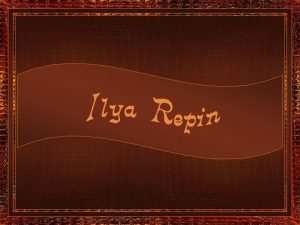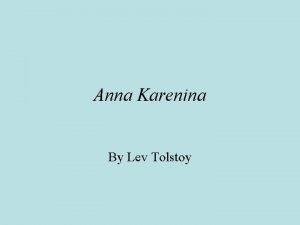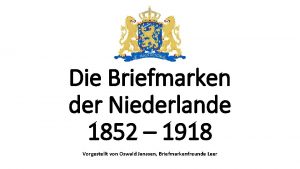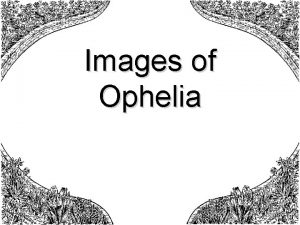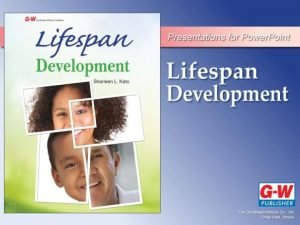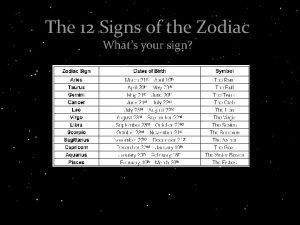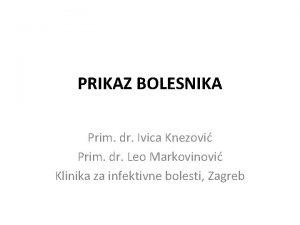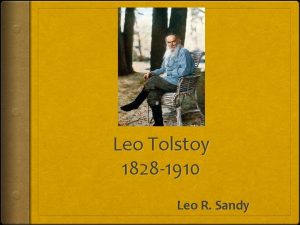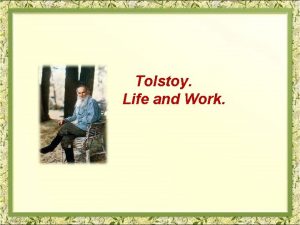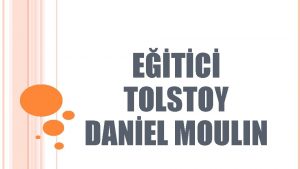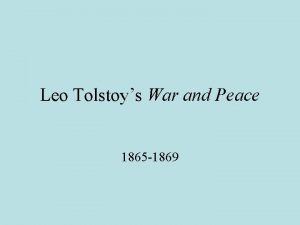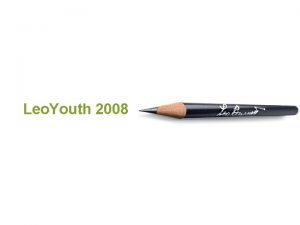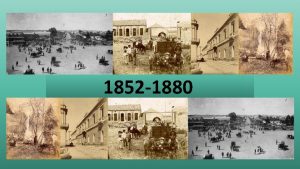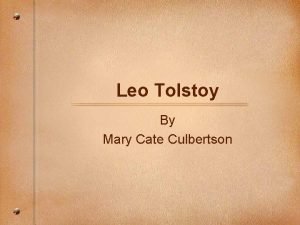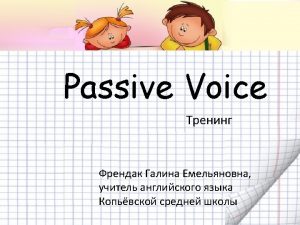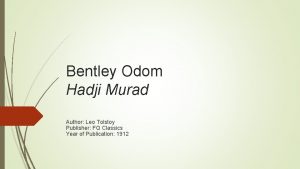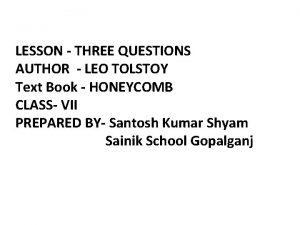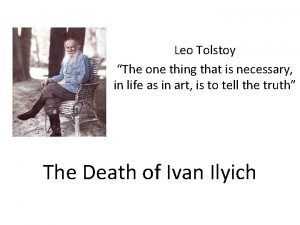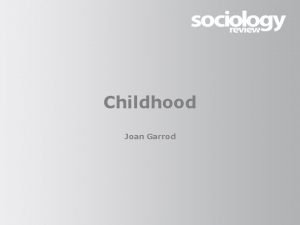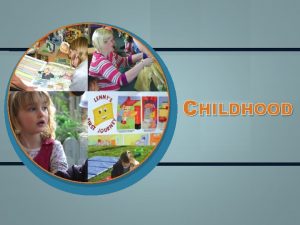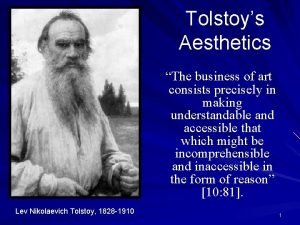Childhood 1852 Leo Tolstoy Key elements of Tolstoys
























- Slides: 24

Childhood (1852) Leo Tolstoy

Key elements of Tolstoy’s approach • Tolstoy’s examination of life on the basis of introspection • Details are examined minutely: dissecting the tissue of experience • Emphasis on individual experience, rather than social existence • The individual’s subjective view is the only interesting one: refusal to generalize • Is there an overarching moral perspective? Is the world only all relative? What is the nature of good and evil? • Sees and represents the world freshly, as if seen for the first time

A new kind of writing • Complete break with Romantic literature, and with a literature focussed on conventions, imitating previous literature. • Lack of fantasy: all the means of narration are focussed on making the reader believe in the events described. (Suspension of disbelief)

Metaphor vs. Metonymy • Russian linguist Roman Jakobson pointed to the two aspects of language: • substitutive vs predicative • substitutive predominates in poetry, uses simile, metaphor, symbols • predicative predominates in prose, adds details, uses synecdoche. • Tolstoy and realist fiction: dearth of metaphor or symbol, emphasis on the particular, detail

Part of larger work • Tolstoy planned four parts. • Only three completed: Childhood, Boyhood, Youth. • Inspired by such works as Dickens’ David Copperfield (1850)

Genre and structure • Genre: best described as a novella, a stream of small events and observations focussed on one person. • Introspective, first-person narrative, broken into short chapter-episodes. • Rooted in autobiography, although not literally a retelling of the author’s life.

Tolstoy and Rousseau • Clear influence of Rousseau’s Confessions • The same desire to expose intimate feelings experienced during childhood, even those of shame, embarrassment and pain • Emphasis on honest portrayal of everything, even the most embarrassing intimate details • Rousseau’s vision of child born pure and corrupted by man • Development of child’s sexuality • Importance of nature as a world outside man • Interest in education theory – the best way to educate children

Jean-Jacques Rousseau (1712 -1778) • « Ce n’est pas ce qui est criminel qui coûte le plus à dire, c’est ce qui est ridicule et honteux » . • “It is not one’s criminal acts that are the most difficult to admit, but those things that are ridiculous and shameful. ” Confessions

Childhood is ahead of its time… • Equivalents in the late nineteenth and early twentieth century: - Anton Chekhov’s The Steppe, a description of a young boy being sent to school, travelling with a caravan of wagons loaded with wool. - Focus on memory points to Marcel Proust’s À la Recherche du temps perdu. - Portrait of a young version of the author suggests James Joyce’s Portrait of the Artist as a Young Man.

Psychological Analysis • Ability to enter into the perceptions of another individual. Later: a horse, a dog. • Shows how behaviours are uncontrollable, growing out of deep emotional issues. • Tolstoy’s analyses of the subconscious foreshadow Sigmund Freud, psychological analyses of the post-Freudian world.

The double perception in Childhood • An older narrator unflinching describing the child’s perceptions and emotions from within. • Describes emotions and behaviours, then clinically analyses them in detail, examining the shifts in perception of the child’s consciousness. • Theme of awkwardness of the child’s view: growing conscious of his errors, feeling shame (frequent word).

The clinical interest • Tolstoy’s analysis is clearly of himself: his own emotions, his own experience of growing up. • Reflects Tolstoy’s scientific interest in children’s development, in education, in society. • Interest in education shades into questions of psychology, philosophy, morality, religion.

The spatial surroundings • The location is divided down the middle: - The country estate of Nikolenka’s parents. - The salons and ballrooms of Moscow.

The cast of characters The family: • Nikolenka Irtenyev • Brother Volodya • Sister Lyubochka • Papa • Maman • In Moscow: Grandmother

The extended household • • Karl Ivanych Marya Ivanovna or Mimi Katyenka – her daughter Natalya Savishna

Outsiders • Grisha the holy fool • Mme Kornakov – “beats children” • The Ivins - Seryozha • Sonechka – first true love. • Ilyinka Grap – the poor little German boy • Ivanych – the rich uncle

Some of the key themes: Childhood • Childhood innocence (Ch. 15, pp. 57 -59) • Naïve, but accurate, judgements of child about adults: who is good and bad. • Moving to Moscow seems a watershed

Some of the key themes: Memory and Maman • Memory – associated with mother, music • Maman pouring tea (Ch. 2, p. 9) • Music and memory (Ch. 11, pp. 41 -42) • Elusiveness of maman’s face (Ch. 14, p. 55) • Later Nikolenka experiences the trauma of mother’s death: maman associated with absence

Some of the key themes: Sexuality Childhood sexuality - Kisses Katya’s shoulder - crush on the boy Seriozha - “unfaithful in love” (p. 97 -98) - Sonechka

Some of the key themes: Family relationships • Relationship to parents, fuzzy understanding of their relationship. • Naïve, but accurate judgements of child about adults: separation into good and bad.

Some of the key themes: Social classes • Class relationships: - snobbery - treatment of poor boy Ilyinka Grap • serfdom: - relationship to servants (domestic serfs), Nikolai, Natalya Savishna - remote perception of the working peasants harvesting in the fields

Some of the key themes: Religion • True religious fervour found among the simple peasant folk: - Grisha the holy fool - Natalya Savishna - mother’s death – outward forms of religion as opposed to deeply felt beliefs

Questions • Do we derive pleasure from reading this novella? • What is aesthetically pleasing about it? • Do we find the descriptions truthful and believable? • What feelings, if any, are stirred in you by this work?

For next class… • Choose one character from the text, and be prepared to describe that person and his or her role. Explain why you chose that person. • In reading Childhood, make a list of the different vices that the narrator exposes in his behaviour. • Study carefully chapters vi, vii and viii; we shall be analyzing them in class.
 How much land does a man need leo tolstoy
How much land does a man need leo tolstoy Ilya tolstoy vera tolstaya
Ilya tolstoy vera tolstaya Greta garbo biografija
Greta garbo biografija Briefmarken niederlande 1852
Briefmarken niederlande 1852 Election of 1852 apush
Election of 1852 apush Nasa evms
Nasa evms Arthur hughes ophelia 1852
Arthur hughes ophelia 1852 Mjera za duljinu u pomorstvu
Mjera za duljinu u pomorstvu Middle childhood
Middle childhood Key partners example business model canvas
Key partners example business model canvas Contoh bisnis model canvas makanan pdf
Contoh bisnis model canvas makanan pdf Chapter 7 early childhood ages 3 through 5
Chapter 7 early childhood ages 3 through 5 Drama literary elements
Drama literary elements Elements and sub elements
Elements and sub elements Hydrosulfuric acid
Hydrosulfuric acid Http //elements.wlonk.com/elements table.htm
Http //elements.wlonk.com/elements table.htm Features of a folk tale
Features of a folk tale Features of folktale
Features of folktale Mythical creature
Mythical creature Leo burg
Leo burg Leo breiman
Leo breiman Oil rig oxidation
Oil rig oxidation Eupnoična
Eupnoična Redox reaction leo ger
Redox reaction leo ger Ger and leo
Ger and leo

